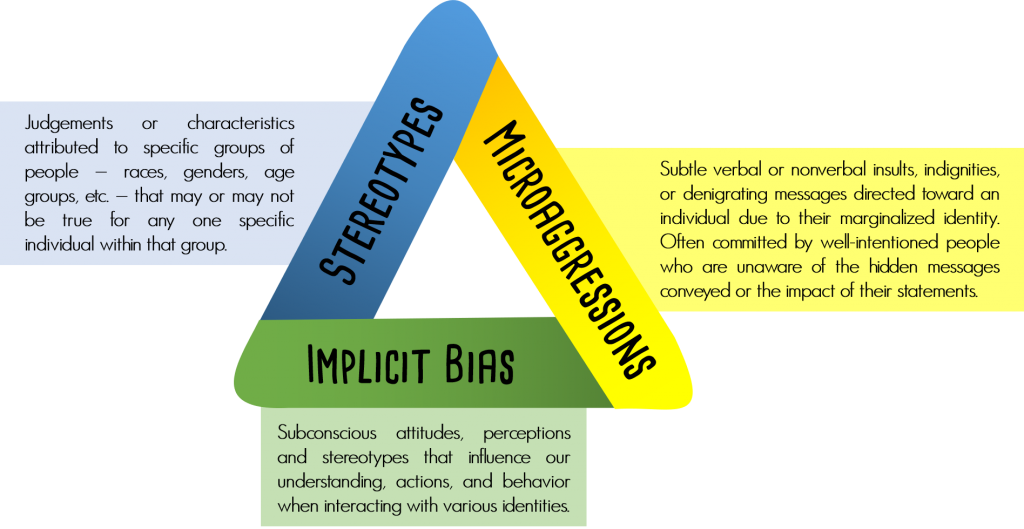| Go Back: Module 3: Defining Race and Racism | You Are Here: Module 4: Implicit Bias and Microaggressions | Next: Module 5: Systems of Inequality |
After working through this module, you will be able to:
- Define implicit bias and microaggression and give examples of these concepts in action.
- Describe how implicit biases are formed and the ways in which they impact the lives of people of color.
- Examine your own biases and their effects on yourself and others.
Introduction
Right now, as you read this text, your brain is working to create meaning from the words on your screen. But that’s not all your brain is doing. It’s also:
- taking in visual stimuli: what you are actively concentrating on viewing as well as visual information from your entire field of vision.
- processing sounds and smells.
- receiving signals from the body that let the brain know your position, your temperature, what you are touching, your current pain, hunger, and energy levels, and hundreds of other physical indicators.
- receiving signals from and sending signals to other areas of the body to help regulate involuntary processes like respiration, circulation, and digestion.
This list could continue, but the point would remain the same: our brains are far more active than our conscious thought patterns suggest. In fact, scientific research shows that the human brain takes in about 11 million bits of information every second – but we are only able to consciously process about 50 bits per second (Markowsky, n.d). That means that the vast majority of the information our brains take in is processed unconsciously. Because the conscious processing power of our brains is so small, we “outsource” a lot of our daily tasks to unconscious processing.
Take driving, for example – when we first learn to drive, it’s a thought-intensive process. You sit in the car and you have to consciously think about checking the mirrors, adjusting the seat, buckling your seatbelt, putting your foot on the brake pedal, putting the key in the ignition, etc. But as we gain more experience, our brains begin to automatically process those tasks, such that for many adults, driving is accomplished almost without conscious thought.
In the influential book Thinking, Fast and Slow, psychologist and Nobel prize-winner Daniel Kahneman described this phenomenon in terms of two systems of thinking. System 1 thinking is fast, automatic, effortless, and occurs with no conscious sense of voluntary control. If someone asks you what 2 plus 2 is, your brain will likely supply the answer before you’ve given the question any conscious thought; that is System 1 at work. System 2 thinking, in contrast, is slow, conscious, explicit, and deliberate. If someone asks you what 126 times 43 is, you would most likely need to engage in System 2 thinking to work out the answer. Kahneman argues that our brains prefer to engage System 1 thinking whenever possible, and when our brains are exposed to the same message or task repeatedly, that message or task will become automatic and virtually involuntary. This way of understanding our thought processes aligns with what neurologists know about the human brain and how learning occurs physiologically.
In many cases, “outsourcing” our thinking to System 1 is beneficial for us. But what happens when our brains receive repeated messages that we might not want or consciously agree with? That is the question we will explore in this module.
 Explore
Explore
Now that you know a little bit about System 1 and System 2 thinking, work through the slideshow below to see how this phenomenon relates to race and racism.
It can be difficult to identify our own implicit biases, or even to admit that we have them. But research has shown that everyone has implicit biases. This does not mean, however, that everyone has the same implicit biases, or that it’s impossible to change one’s implicit biases. Research into “debiasing” is still in its early stages, but so far, results suggest that changing or eliminating one’s implicit biases requires time, intention, and training. Beyond the individual level, implicit biases may also be changed collectively over time by changing the narratives that appear in media. When people argue that “representation matters” in books, movies, and other forms of media, this is part of the reason why: if our media culture is filled with positive representations of people of color, Indigenous people, and other marginalized people, over time we may rewrite the general narratives that form the foundation for implicit biases against these groups.
Implicit Bias: Key Concepts
- Implicit biases are attitudes or stereotypes that unconsciously affect our actions, decisions, and understanding.
- Implicit biases can be positive (a preference for something or someone) or negative (an aversion to or fear of something or someone).
- Implicit biases are different from known biases that people may choose to conceal for social or political reasons. In fact, implicit biases often conflict with a person’s explicit and/or declared beliefs.
- Implicit biases are formed over a lifetime as a result of exposure to direct and indirect messages. The media plays a large role in this formation process.
- Implicit biases are pervasive: everyone has them.
- Implicit biases are changeable, but research shows that this process takes time, intention, and training.
 Watch
Watch
In the video below, CNN journalist Van Jones gives a brief overview of implicit bias and references some of the ways it has manifested in recent events.
The Kirwan Institute is a leader in the field of implicit bias research. Watch their video below, in which they explore some of the ways that individual impacts of implicit bias can compound to create large negative impacts for people of color.
What does the research say?
Research into implicit bias has helped to uncover some of the ways that implicit bias impacts marginalized people and communities. The studies listed below are only a small sample of the large body of research in this field, and only include studies related to race. Other research has shown that implicit biases also function along other lines of marginalization such as gender and disability.
- Preschool teachers were shown a video of four children playing: one white female, one white male, one Black female, and one Black male. The 135 teachers were instructed to look for “challenging behavior” among the students, and their eye movements were tracked while they watched the video. Although there was no challenging behavior actually depicted in the video, the teachers spent the most time observing the Black male child, and when asked, identified him as the child who needed the most attention (Gilliam, Maupin, Reyes, Accavitti, & Shic, 2016).
- When provided with discipline scenarios that differed only in the students’ name, teachers were more likely to escalate the response to a second infraction for students perceived to be Black than for students perceived to be white (Okunofua & Eberhart, 2015). In addition, teachers were more likely to view individual infractions as representing a larger pattern of misbehavior when the student was perceived to be Black (Smith, 2015).
- In an interview study involving 16,000 racially diverse U.S. teachers, respondents were asked to predict their 10th-graders’ future educational attainment. When asked about any specific Black student, white teachers were about 30 percent less likely than Black teachers to predict he or she would someday earn a college degree. For white students, the teachers’ expectations were about the same (Gershenson, Holt, & Papageorge, 2015).
- Repeated studies have shown that people perceive young Black men as bigger (taller, heavier, more muscular) and more physically threatening (stronger, more capable of harm) than young white men of the same actual size. Participants in these studies were more likely to condone the hypothetical use of force against Black men compared to white men on the basis of this perceived threat (Wilson, Hugenberg, & Rule, 2017).
- Given patients indicating identical pain levels, doctors and other medical staff are less likely to prescribe pain medication to Black patients than to white patients (Hoffman, Trawalter, Axt, & Oliver, 2016).
- Repeated experiments have shown that Black and Latinx job applicants are significantly less likely to receive a callback than white applicants with identical resumes (e.g. Pager, Bonikowski, & Western, 2009).
- When they received e-mails from fictional prospective doctoral students seeking to schedule a meeting, white males were granted access to faculty members 26% more often than women and people of color (the study treated all women and all POC regardless of gender as a single category). White males also received more and faster responses (Milkman, Akinola, & Chugh, 2012).
 Listen
Listen
After a 2018 incident in Philadelphia where two Black men were arrested at a Starbucks store, the coffee company decided to close all 8,000 of its stores for an afternoon to provide implicit bias training for its staff. Listen to the NPR All Things Considered segment below, in which Perception Institute director Alexis McGill Johnson explains how racial biases might be lessened over time with intentional effort.
 Interact
Interact
Researchers at Harvard have developed over a dozen tests for measuring implicit bias related to race, sexuality, disability, religion, and other forms of prejudice as part of Project Implicit. Visit the project’s Take a Test site and take the Race IAT (you may also choose to take other tests). After you view your results, reflect on the test itself, your experience taking the test, and your interpretation of the results.
 Reflect
Reflect
In this blog post from Ensemble Learning, several educators wrote about times they realized they were acting from a place of implicit bias, either from their own education or from other people pointing it out to them. Read their reflections here, then respond to the questions below in your journal:
- Can you think of similar instances where you have formed snap judgments about a student or young library user based on race (or another characteristic)? What were the consequences of these judgments for the child or teen? For yourself?
- Make a plan for collecting some data about your interactions with BIYOC and their families over the next several days (depending on your work situation, you may need to collect data for longer to get a complete picture of these interactions). You may try to look holistically at these interactions, or you might choose to focus only on one type of interaction – verbal communication or disciplinary actions, for example. Take notes about what you choose to observe. Do you notice any patterns? Did any of the data surprise you?
 Act
Act
Anti-bias trainings and workshops are available both in-person and online. One popular option is a free, one-hour, interactive webinar regularly offered by Right to Be, an organization that aims to prevent harassment. Another option is the 4-module sequence on Implicit Bias offered by the Kirwan Institute. Consider participating in one of these trainings, or look for an in-person training near you.
Microaggressions
Implicit biases can impact our relationships and interactions with each other in many ways, some of which are described in the research findings listed above. One way that implicit biases can manifest is in the form of microaggressions: subtle verbal or nonverbal insults or denigrating messages communicated toward a marginalized person, often by someone who may be well-intentioned but unaware of the impact their words or actions have on the target. Examples of common microaggressions include statements like:
- Where are you really from?
- What are you?
- You don’t act like a normal Black person.
- You’re really pretty for a dark-skinned girl.
Microaggressions can be based on any aspect of a marginalized person’s identity (for example, sexuality, religion, or gender). Individual microaggressions may not be devastating to the person experiencing them; however, their cumulative effects over time can be large. The Tumblr blog Microaggressions, which aims to “mak[e] visible the ways in which social difference is produced and policed in everyday lives,” describes this as follows:
Often, [microaggressions] are never meant to hurt – acts done with little conscious awareness of their meanings and effects. Instead, their slow accumulation during a childhood and over a lifetime is in part what defines a marginalized experience, making explanation and communication with someone who does not share this identity particularly difficult. Social others are microaggressed hourly, daily, weekly, monthly.
In his research, Dr. Derald Wing Sue found that BIPOC experience microaggressions every day – from the time they get up in the morning until they go to bed at night. In his workshops, Sue asks white people in the room this question: “Do you know what it’s like to be a black person in this society where you go into a subway and you sit down and people never sit next to you? Do you know what it’s like to pass a man or a woman, and they suddenly clutch their purses more tightly?” As he notes, many whites have never thought about how this feels because they don’t live this reality. It is invisible to them. By asking this question, Sue’s goal is to make the invisible visible, to get white people to “see” the microaggressions BIPOC experience on a daily basis, and to challenge them to understand how those microaggressions negatively impact the daily lived experiences of BIPOC.
To learn more about how young people experience microaggressions, watch the video below, in which college students share their personal stories related to this issue.
Who is…
Dr. Derald Wing Sue

Dr. Derald Wing Sue is a professor of psychology at Columbia University’s graduate school of education. He has been writing about microaggressions for more than 20 years.
To learn more about Dr. Sue and his work:
For a discussion about the forms implicit bias might take in a library setting, watch this excerpt from a YALSA webinar presented by Dr. Nicole Cooke.
What’s the Impact on BIYOC?
Pervasive implicit bias and microaggressions do more than simply cause BIYOC to “feel bad.” Constant exposure to racism in both implicit and explicit forms can have cumulative and serious impacts on BIPOC. Researchers are only now beginning to identify and understand some of these impacts. For example, scientists have begun linking prolonged racism-related stress to racial health disparities such as differences in maternal mortality rates between Black and white women. Other racial health disparities, such as differing rates of asthma and diabetes across racial groups, may also be linked to the stress impact of racism. Stress hormones, while harmless in small doses, are toxic with prolonged exposure, and can cause permanent damage to the nervous, cardiovascular, immune, and endocrine systems.
In addition to health disparities, the so-called “racial achievement gap” in education has also been attributed at least in part to the presence of implicit bias, stereotypes, and microaggressions. In the 1990s, psychologists Claude Steele and Joshua Aronson provided empirical evidence for the impact of “stereotype threat” on academic performance. The idea behind stereotype threat is that awareness of negative stereotypes about one’s racial group raises stress and self-doubt among students, who then perform worse. Over two decades of data show that stereotype threat is common and consequential. For a summary of this phenomenon and related studies, read the American Psychological Association’s “Research in Action” page.
In her research, Dr. Patricia F. Katopol looks at the impact of stereotype threat on the use of library reference services by BIPOC, specifically African American college students at primarily white institutions. Katopol argues that stereotype threat may be an element of information anxiety – an element that leads many Black students to attempt to find all of the information they need on their own rather than having to interact with librarians who they perceive as judging them. To learn more about stereotype threat in library settings, read her article Stereotype Threat and the Senior Library Patron in Library Leadership & Management, an open-source journal.
In each of these cases, current research is challenging our notions of cause and effect when it comes to implicit bias, stereotypes, racism, and life outcomes. Rather than attributing the causes of disparate life outcomes to inherent racial differences, this research asks us to consider racism itself as the cause. This is a perspective we will continue to explore later in this curriculum.
Tying it All Together
Implicit biases, microaggressions, and stereotypes are interrelated concepts. Implicit biases are developed through exposure to stereotypes and other forms of misinformation over time. These implicit biases can then lead well-intentioned people to commit microaggressions against people of color, Native people, and others with marginalized identities. The diagram below provides summary definitions for each of these three concepts.
For additional clarification, watch the Crash Course Pyschology video below, which discusses these terms along with the related terms “prejudice” and “discrimination.”
 But Wait!
But Wait!
In this section, we address common questions and concerns related to the material presented in each module. You may have these questions yourself, or someone you’re sharing this information with might raise them. We recommend that for each question below, you spend a few minutes thinking about your own response before clicking the arrow to the left of the question to see our response.
Does EVERYONE really have implicit biases?With all of the recent examples of overt racism, shouldn't we be more concerned with that and less concerned with implicit bias?
Learning about microaggressions just makes me more hesitant to talk to people of color for fear I'll say something wrong. Isn't this just another issue that divides us rather than unites us?
I was just told that a comment I made was inappropriate and biased, but I did not mean for it to be. How do I explain what I really meant?
 Additional Resources
Additional Resources
For more information about the causes and consequences of implicit bias, check out:
- the Kirwan Institute for the Study of Race and Ethnicity’s Understanding Implicit Bias site.
- the Perception Institute report Transforming Perception: Black Men and Boys [PDF], which looks specifically at how implicit biases negatively impact Black males.
- Challenging the Algorithms of Oppression, a talk given by Professor Safiya Noble, in which she explores the biases contained information retrieval systems and how they impact BIPOC.
- Claude Steele’s book Whistling Vivaldi: How Stereotypes Affect Us and What We Can Do in which Steele draws on personal stories and research to demonstrate how simply being aware of negative stereotypes toward our social group diminishes our ability to perform.
References
Gilliam, W. S., Maupin, A. N., Reyes, C. R., Accavitti, M., & Shic, F. (2016). Do early educators’ implicit biases regarding sex and race relate to behavior expectations and recommendations of preschool expulsions and suspensions? Yale Child Study Center. Retrieved from https://medicine.yale.edu/childstudy/zigler/publications/Preschool%20Implicit%20Bias%20Policy%20Brief_final_9_26_276766_5379_v1.pdf.
Gershenson, S., Holt, S. B., & Papageorge, N. W. (2015). Who believes in me? The effect of student-teacher demographic match on teacher expectations. Upjohn Institute Working Paper 15-231. Kalamazoo, MI: W.E. Upjohn Institute for Employment Research.
Markowsky, G. (n.d.). Information theory: Physiology. Retrieved from https://www.britannica.com/topic/information-theory/Physiology.
Milkman, K. L., Akinola, M., & Chugh, D. (2012). Temporal distance and discrimination: An audit study in academia. Psychological Science 23(7), 710 – 717.
Okonofua, J. A., & Eberhardt, J. L. (2015). Two strikes: Race and the disciplining of young students. Psychological Sciences.
Pager, D., Bonikowski, B., & Western, B. (2009). Discrimination in a low-wage labor market: A field experiment. American Sociological Review 74(5), 777-799.
Smith, J. A. (2015). Why teachers are more likely to punish black students. Greater good: The science of a meaningful life. Retrieved from http://greatergood.berkeley.edu/article/item/why_teachers_are_more_likely_to_punish_black_students?utm_source=GGSC+Newsletter+-+May+2015&utm_campaign=GG+Newsletter+-+May+2015&utm_medium=email.
Wilson, J. P, Hugenberg, K., & Rule, N. O. (2017). Racial bias in judgments of physical size and formidability: From size to threat. Journal of Personality and Social Psychology 113(1), 59 – 80.
| Go Back: Module 3: Defining Race and Racism | You Are Here: Module 4: Implicit Bias and Microaggressions | Next: Module 5: Systems of Inequality |

